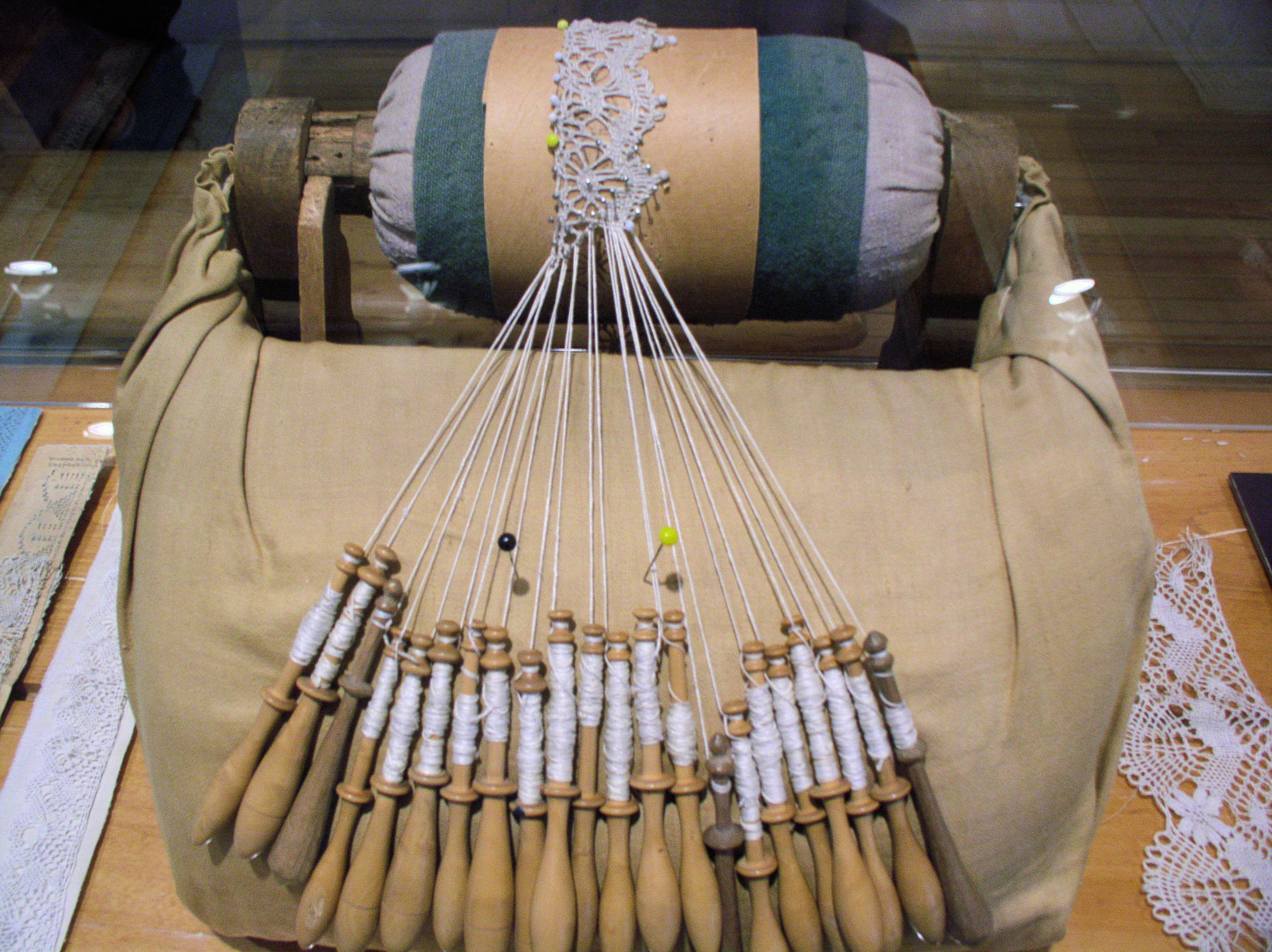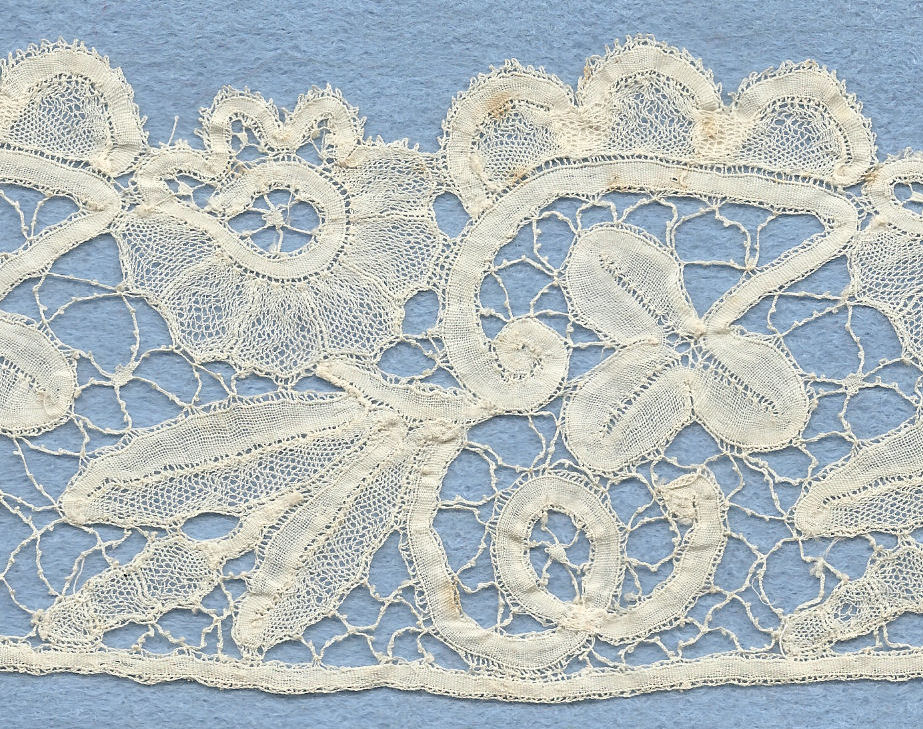|
Part Lace
Part lace or sectional lace is a way of making bobbin lace. It characterises various styles, such as Honiton lace or Brussels lace. All bobbin lace is made with bobbins on a lace pillow. Some styles of lace are made in a continuous strip. Since there is a limit to how many bobbins can be handled on a pillow, this limits how wide the lace is. Part lace, on the other hand, is made in pieces or motifs. Once made, these are joined together in a ground, net or mesh, or with plaits, bars or legs. This means that the lace has no limit in size, apart from the time needed to make it. It can also be made by a team of lacemakers. "Real Honiton laces are made up of bits and bits fashioned by many different women in their own little cottages - here a leaf, there a flower, slowly woven through the long, weary days, only to be united afterward in the precious web by other workers who never saw its beginning." Part lace may be identified by the ground or plaits being separate from the motifs an ... [...More Info...] [...Related Items...] OR: [Wikipedia] [Google] [Baidu] |
Honiton Knot
Honiton ( or ) is a market town and civil parishes in England, civil parish in East Devon, situated close to the River Otter, Devon, River Otter, north east of Exeter in the county of Devon. Honiton has a population estimated at 11,822 (based on mid-year estimates for the two Honiton Wards in 2009). History The town grew along the line of the Fosse Way, the ancient Roman road linking Exeter (Isca Dumnoniorum) to Lincoln, Lincolnshire, Lincoln (Lindum). Contrary to 19th-century theories, it is unlikely to have been known as a stopping-point by the Romans, who built a small fort for that purpose just to the west of the present town. Honiton's location is mentioned in the Domesday Book as Honetone, meaning Huna's tun or farmstead. Lace-making Honiton later grew to become an important market town, known for Bobbin lace, lace making that was introduced by Flemish people, Flemish immigrants in the Elizabethan era. In the 17th century thousands of people produced lace by hand in ... [...More Info...] [...Related Items...] OR: [Wikipedia] [Google] [Baidu] |
Bobbin Lace
Bobbin lace is a lace textile made by braiding and twisting lengths of thread, which are wound on bobbins to manage them. As the work progresses, the weaving is held in place with pins set in a lace pillow, the placement of the pins usually determined by a pattern or pricking pinned on the pillow. Bobbin lace is also known as pillow lace, because it was worked on a pillow, and bone lace, because early bobbins were made of bone or ivory. Bobbin lace is one of the two major categories of handmade laces, the other being needle lace, derived from earlier cutwork and reticella. Origin A will of 1493 by the Milanese Sforza family mentions lace created with twelve bobbins. There are two books that represent the early known pattern descriptions for bobbin lace, ''Le Pompe'' from Venice and ''Nüw Modelbuch'' from Zürich. Bobbin lace evolved from passementerie or braid-making in 16th-century Italy. Genoa was famous for its braids, hence it is not surprising to find bobbin lace de ... [...More Info...] [...Related Items...] OR: [Wikipedia] [Google] [Baidu] |
Honiton Lace
Honiton lace is a type of bobbin lace made in Honiton, Devon, in the United Kingdom. Historical Honiton lace designs focused on scrollwork and depictions of natural objects such as flowers and leaves. Characteristics Honiton lace is a part lace. Its ornate motifs and complex patterns are created separately, before being sewn into a net ground. Common motifs include daisies, roses, shamrocks, ivy leaves, butterflies, lilies, camellias, convolvulus, poppies, briony, antwerp diamonds, trefoils, ferns, and acorns. Origin and history The art of making lace is rumored to have been brought to Honiton, England by Flemish refugees in the mid-to-late 16th century. An old tombstone in the town is inscribed with information about one James Rodge who is described as a “bone lace seller” who died in 1617; it is not known whether he emigrated from Flanders or not. In the early period (approx. 1620-1800), sprigs of various designs were worked separately from the net ground by hand, ... [...More Info...] [...Related Items...] OR: [Wikipedia] [Google] [Baidu] |
Brussels Lace
Brussels lace is a type of pillow lace that originated in and around Brussels."Brussels." ''The Oxford English Dictionary''. 2nd ed. 1989. The term "Brussels lace" has been broadly used for any lace from Brussels; however, strictly interpreted, the term refers to bobbin lace, in which the pattern is made first, and the ground, or ''réseau'' added, also using bobbin lace. Brussels lace is not to be confused with Brussels point (or Point de Gaze), which is a type of needle lace, though sometimes also called "Brussels lace". Brussels lace is well known for its delicacy and beauty. Originally it was only made from the finest spun linen thread, which was spun in dark damp rooms to keep the thread from becoming too brittle. Only one ray of light was allowed into the room, and it was arranged so that it fell upon the thread. This fine thread was one reason preventing mechanization of the process of making Brussels lace, as well as the production of it in other regions, as it could not ... [...More Info...] [...Related Items...] OR: [Wikipedia] [Google] [Baidu] |
Lace Pillow
Bobbin lace is a lace textile made by braiding and twisting lengths of thread, which are wound on bobbins to manage them. As the work progresses, the weaving is held in place with pins set in a lace pillow, the placement of the pins usually determined by a pattern or pricking pinned on the pillow. Bobbin lace is also known as pillow lace, because it was worked on a pillow, and bone lace, because early bobbins were made of bone or ivory. Bobbin lace is one of the two major categories of handmade laces, the other being needle lace, derived from earlier cutwork and reticella. Origin A will of 1493 by the Milanese Sforza family mentions lace created with twelve bobbins. There are two books that represent the early known pattern descriptions for bobbin lace, ''Le Pompe'' from Venice and ''Nüw Modelbuch'' from Zürich. Bobbin lace evolved from passementerie or braid-making in 16th-century Italy. Genoa was famous for its braids, hence it is not surprising to find bobbin lace deve ... [...More Info...] [...Related Items...] OR: [Wikipedia] [Google] [Baidu] |
Bobbin Tape Lace
Bobbin tape lace is bobbin lace where the design is formed of one or more tapes curved so they make an attractive pattern. The tapes are made at the same time as the rest of the lace, and are joined to each other, or themselves, using a crochet hook. The tapes are made curved, and by hand, using bobbin lace techniques. This should be distinguished from mixed tape lace, which is made using an existing straight tape, often machine made. Types of bobbin tape lace include Russian lace, Idrija Idrija (, in older sources ''Zgornja Idrija''; german: (Ober)idria, it, Idria) is a town in western Slovenia. It is the seat of the Municipality of Idrija. It is located in the traditional region of Inner Carniola and is in the Gorizia Statisti ..., Schneeberg, Milanese lace and Hinojosa lace. Bobbin tape lace is sometimes categorized as part lace. References {{lace types Bobbin lace ... [...More Info...] [...Related Items...] OR: [Wikipedia] [Google] [Baidu] |






